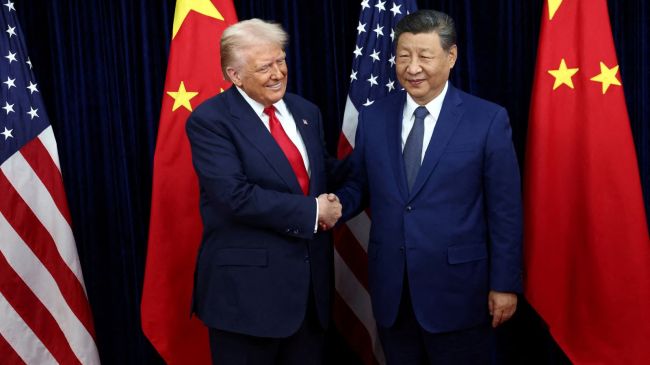Opinion Xi has made it clear to Trump: The red line is Taiwan
This framing links Taiwan to grand international principles and signals to the US that support for the “One China Principle” remains non-negotiable for Beijing
 It is now also clear that the call was initiated by Trump, as confirmed by Mao Ning
It is now also clear that the call was initiated by Trump, as confirmed by Mao Ning The recent phone call between US President Donald Trump and China’s President Xi Jinping, among other things, pointed to the differences in each side’s perception of what matters. A month after the two leaders met in Busan, South Korea, the call acted as a reminder of the commitments they are required to follow through in two main domains — trade and technological exchanges.
It is now also clear that the call was initiated by Trump, as confirmed by Mao Ning of the Chinese Foreign Affairs Ministry and US Treasury Secretary Scott Bessent. And even as their respective readouts do show that there is a willingness to resolve issues, there are also significant faultlines — starting with signalling up to “red line” issues.
While Washington is yet to release a press note, Xinhua has already presented Beijing’s version of the conversation. Trump has posted his remarks on the call on Truth Social. There are three main takeaways from China’s perspective on the call.
First, for China, the Busan summit and the latest phone call helped to “calibrate the course” and inject new momentum into a more stable, cooperative China-US relationship. Xi’s reiteration that the principle of “cooperation benefits both sides, while confrontation harms both” reflects Beijing’s desire to consolidate recent positive trends and avoid a return to heightened rivalry.
Beijing clearly seeks to maintain this momentum, emphasising an agenda of extending cooperation, reducing tensions, and reaping mutual benefit. After all, at a time when markets and economies globally have turned hostile to the Chinese model of economic growth, a semblance of stability in its ties with the US is ideal. The articulation also classically represents the tactical breathing room both sides agreed was achieved in the aftermath of the Busan meeting, albeit with recognition that underlying competition persists.
Second, Xi used the call to forcefully reiterate that Taiwan’s “return to China is an important component of the post-war international order,” tying it not just to Chinese sovereignty but to the legacy of Allied victory in WWII. This framing links Taiwan to grand international principles and signals to the US that support for the “One China Principle” remains non-negotiable for Beijing.
In the aftermath of tensions stirred between China and Japan over Taiwan, with the Japanese Prime Minister Sanae Takaichi pledging military support to the island in the event of a conflict with China, it is ironic but understandable why Beijing thought it necessary to file an official complaint with the US. To Trump’s credit, he soon also made a call to Takaichi, where she spoke highly of the close ties the US and Japan share. Nonetheless, Beijing stands firm in its condemnation of Japan’s apparent violations of the post-war order and the One-China Principle. Not to mention, tensions with Tokyo have escalated, given that Chinese Premier Li Qiang refused to meet with Takaichi on the sidelines of the recently concluded G20 Summit.
Third, Xi stressed China’s support for “all efforts conducive to peace” in Ukraine and expressed hope for a “fair, lasting, and binding peace at the root.” Despite the friendly ties with Russia, such an articulation fits with China’s standing diplomatic message that it seeks negotiated settlements and opposes protracted confrontation. It seeks an active voice in new global security arrangements.
With Washington intensifying efforts for a Ukraine peace initiative by Thanksgiving, and China maintaining robust ties with Moscow, Beijing is carefully signalling willingness to align with US diplomatic efforts while not alienating Russia. Potentially, it is also China’s way to assuage American concerns on something that matters to them – ending Russia’s campaign – in exchange for Washington’s acknowledgement of China’s Taiwan red line.
While an official White House press release is awaited, it is interesting to note that Trump’s main takeaway from the meeting is his interpretation that China has conceded to the bidding of the US’s “Great Farmers”. Other linguistic and material differences in the two sides’ articulations are essential to note: Trump calls his relations with China “extremely strong;” Xinhua comments that Trump called Xi a “great leader.”
Further, Trump’s post mentions Ukraine, but makes no mention of a discussion on Taiwan. At the same time, Xinhua’s release makes no mention of fentanyl or soybeans, while those turn out to be the main issue areas from Trump’s perspective. Finally, Trump discusses leaders of the two sides visiting each other’s countries in 2026, but the Xinhua release says nothing on that front.
The signalling on either side is firm and pertains only to self-interest. Even as a temporary truce between the two countries is underway, structural faultlines continue to persist, and neither side seems to even illusorily agree to concessions.
The writer is Staff Research Analyst, Indo-Pacific Studies Programme, the Takshashila Institution, Bengaluru





